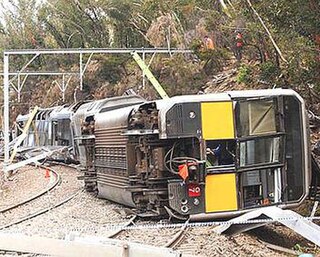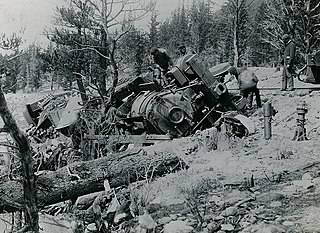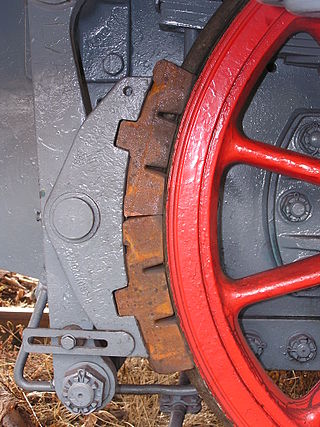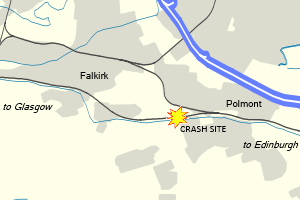
On 3 June 1998, an ICE 1 train on the Hannover-Hamburg railway near Eschede in Lower Saxony, Germany derailed and crashed into an overpass that crossed the railroad, which then collapsed onto the train. 101 people were killed and at least 88 were injured, making it the second-deadliest railway disaster in German history after the 1939 Genthin rail disaster, and the world's worst ever high-speed rail disaster.

A conductor or guard is a train crew member responsible for operational and safety duties that do not involve actual operation of the train/locomotive. The conductor title is most common in North American railway operations, but the role is common worldwide under various job titles. In Commonwealth English, a conductor is also known as guard or train manager.
The Armagh rail disaster happened on 12 June 1889 near Armagh, County Armagh, in Ireland, when a crowded Sunday school excursion train had to negotiate a steep incline; the steam locomotive was unable to complete the climb and the train stalled. The train crew decided to divide the train and take forward the front portion, leaving the rear portion on the running line. The rear portion was inadequately braked and ran back down the gradient, colliding with a following train.

On trains, the expression emergency brake has several meanings:

The Waterfall rail accident was a train accident that occurred on 31 January 2003 near Waterfall, New South Wales, Australia. The train derailed, killing seven people aboard, including the train driver. The accident is famously remembered by systems engineers due to the poorly designed safety systems.

In rail transport, a derailment occurs when a rail vehicle such as a train comes off its rails. Although many derailments are minor, all result in temporary disruption of the proper operation of the railway system and they are a potentially serious hazard.

A railway brake is a type of brake used on the cars of railway trains to enable deceleration, control acceleration (downhill) or to keep them immobile when parked. While the basic principle is similar to that on road vehicle usage, operational features are more complex because of the need to control multiple linked carriages and to be effective on vehicles left without a prime mover. Clasp brakes are one type of brakes historically used on trains.

The Southall rail crash occurred on 19 September 1997, on the Great Western Main Line at Southall, West London. An InterCity 125 high speed passenger train (HST) failed to slow down in response to warning signals and collided with a freight train crossing its path, causing seven deaths and 139 injuries.
The Norton Fitzwarren rail crash occurred on 4 November 1940 between Taunton and Norton Fitzwarren in the English county of Somerset, when the driver of a train misunderstood the signalling and track layout, causing him to drive the train through a set of points and off the rails at approximately 40 miles per hour (64 km/h). 27 people were killed. The locomotive involved was GWR King Class GWR 6028 King Class King George VI which was subsequently repaired and returned to service. A previous significant accident occurred here on 10 November 1890 and the Taunton train fire of 1978 was also within 2 metres.
The Ghotki rail crash occurred on 13 July 2005, at around 3:40am local time near Ghotki, Pakistan. No. 24 Dn train stopped at the station of Sarhad was hit from behind by the following Karachi Express train, causing several cars to derail; these were then hit by a third train running in the opposite direction (Tezgam). A total of seventeen train cars, carrying over 3000 passengers, were wrecked. Estimates of the death toll ranged as high as over 130. It was the worst train accident in Pakistan in fifteen years.

The Harrow and Wealdstone rail crash was a three-train collision at Harrow and Wealdstone station in Wealdstone, Middlesex during the morning rush hour of 8 October 1952. The crash resulted in 112 deaths and 340 injuries, 88 of these being detained in hospital. It remains the worst peacetime rail crash in British history and the second deadliest overall after the Quintinshill rail disaster of 1915.

The Polmont rail accident, also known as the Polmont rail disaster, occurred on 30 July 1984 to the west of Polmont, near Falkirk, in Scotland. A westbound push-pull express train travelling from Edinburgh to Glasgow struck a cow which had gained access to the track through a damaged fence from a field near Polmont railway station, causing all six carriages and the locomotive of the train to derail. 13 people were killed and 61 others were injured, 17 of them seriously. The accident led to a debate about the safety of push-pull trains on British Rail.
The Darlington rail accident occurred on the evening of 27 June 1928 when a parcels train and an excursion train collided head on at Darlington Bank Top railway station in County Durham, England. The accident was caused by the parcels train driver passing a signal at danger, due to misunderstanding the signalling layout in an unfamiliar part of the station. This accident resulted in the deaths of 25 people and the serious injury of 45 people.

The Shrewsbury rail accident occurred on 15 October 1907. An overnight sleeping-car and mail train from Manchester to the West of England derailed on the sharply curved approach to Shrewsbury station, killing 18 people and injuring 33. The accident was concluded to be due to excessive speed on a dangerous curve.
The Norton Fitzwarren rail crash occurred on 11 November 1890, at Norton Fitzwarren station on the Great Western Railway, approximately two miles south-west of Taunton in Somerset. A special boat train carrying passengers from Plymouth to Paddington collided with a goods train that was being shunted on the main line. Ten passengers were killed, and eleven people were seriously injured. Another significant accident occurred at Norton Fitzwarren in 1940.
The Slough rail accident happened on 16 June 1900 at Slough railway station on the Great Western Main Line when an express train from London Paddington to Falmouth Docks ran through two sets of signals at danger, and collided with a local train heading for Windsor & Eton Central. Five passengers were killed; 35 were seriously injured, and 90 complained of shock or minor injuries
The Ballymacarrett rail crash occurred on 10 January 1945 at 7:50am in the Ballymacarrett area of Belfast, County Down, Northern Ireland on the Belfast to Bangor Line of the Belfast and County Down Railway, when a train led by a heavy autotrain driving trailer ran into the back of a stopped passenger train consisting of lightweight wooden coaches. 22 died with 27 injured. It was the worst crash in Northern Ireland since 1889. The cause was found to be carelessness of the driver of the autotrain who was running too fast for conditions. Fog, unsafe railway rules, and possible distraction from passengers all may have contributed to the accident. Old lightweight rolling stock contributed to the great number of injuries and deaths. The accident led to the demise of the railway company which was nationalised three years later.
On 3 February 2003, a Comeng electric multiple unit train rolled away from Broadmeadows station in Melbourne, Australia, before it ran for nearly 17 kilometres (11 mi) out of control without a driver and eventually crashed into another train about to depart Spencer Street station. Train controllers attempted several times to stop or redirect the train, but were limited in their ability to intervene, instead being forced to alter the route of other trains to avert a more serious collision. Eleven people on board the stationary train were injured; authorities did not know until after the crash if any passengers were on board the runaway. An investigation identified driver error as the cause of the accident, but the runaway event prompted significant debate about the role of government authorities and private operators in ensuring safety and reliability on the Melbourne rail network.

On the evening of 26 December 1962, cold weather and snow in and around Crewe had caused points to become frozen and trains were being detained at signals. About midway between Winsford and Crewe, the 13:30 Glasgow Central to London Euston Mid-Day Scot, hauled by an English Electric type 4 diesel, D215, with 13 coaches and 500 passengers, was stopped at a signal but the driver found the telephone to Coppenhall Junction, the next signal box ahead, out of order. Seeing the next signal ahead he decided to proceed down towards it and use the telephone there, but too fast. In the darkness he failed to notice the 16:45 express from Liverpool Lime Street to Birmingham New Street, hauled by an electric locomotive with eight coaches with 300 passengers, standing on the line ahead and collided with it at about 20 mph (32 km/h).










